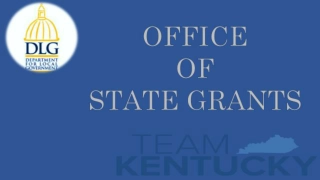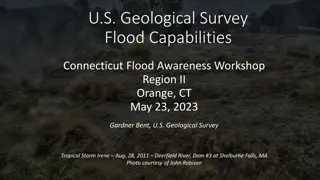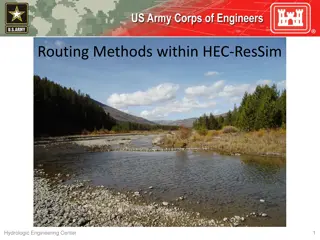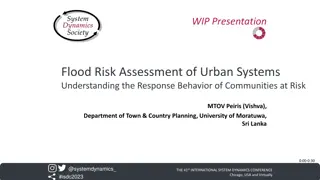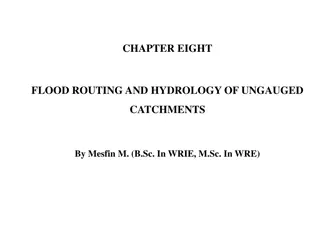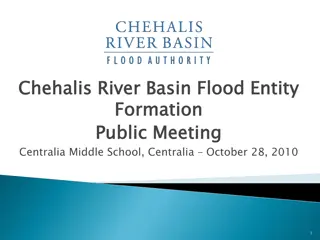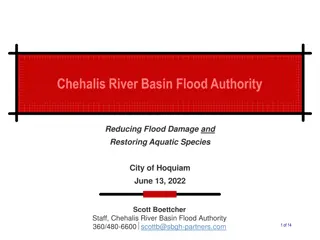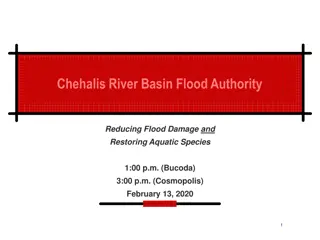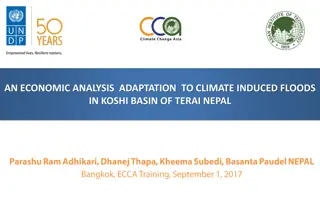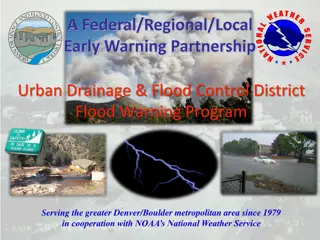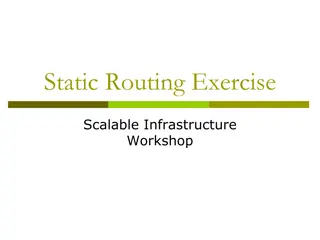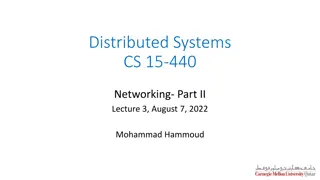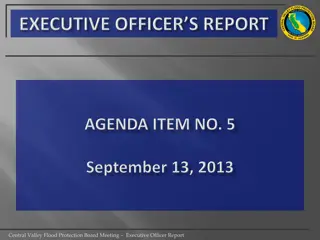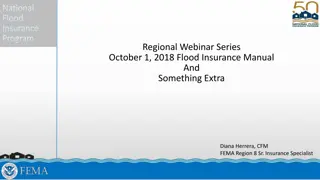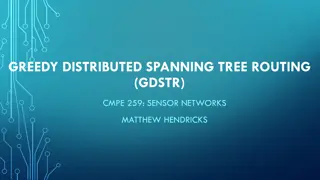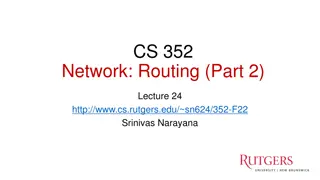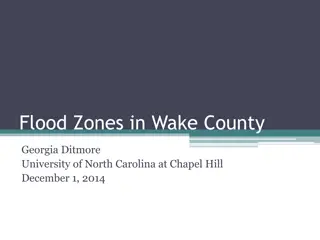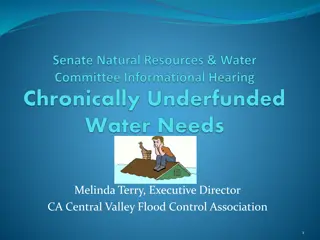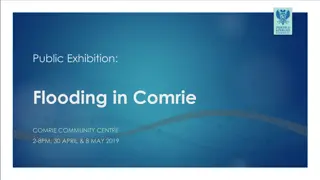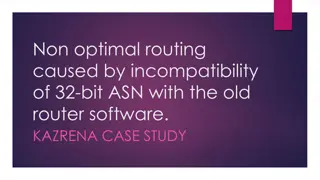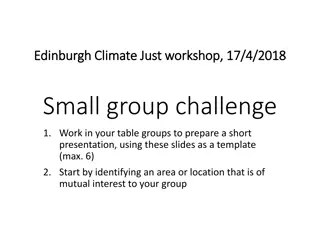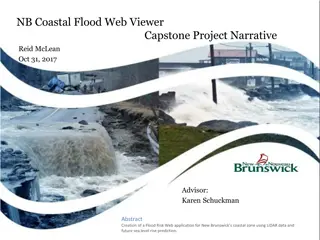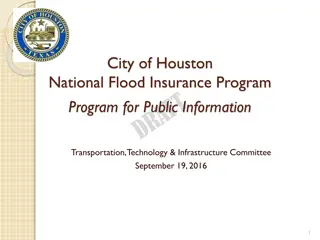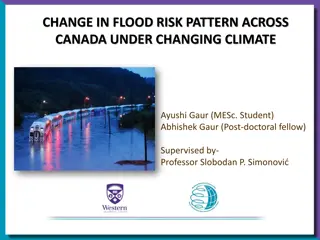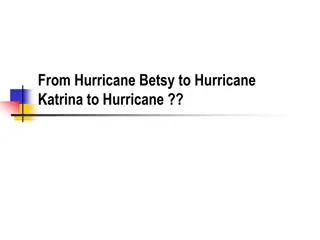Office Of State Grants
The Flood Control Local Match Participation Program (LMPP) provides grants to help local governments meet non-Federal cost-share requirements for flood-related projects, flood control planning, and mitigation activities. Funding can be used as matching funds with various federal agencies and program
2 views • 9 slides
Understanding the National Flood Insurance Program (NFIP) and Floodplain Management
Explore the National Flood Insurance Program (NFIP) and its workshops across Connecticut, covering topics such as flood awareness, certified floodplain management, flood maps, roles and responsibilities, and the significance of the 100-year floodplain. Learn how FEMA, the State NFIP Coordinator, and
0 views • 37 slides
Introduction to Flood Risk Assessment with HEC-FDA Overview
This presentation delves into flood risk assessment using HEC-FDA software, covering topics such as defining flood risk, components of uncertainty, consequences of flood risk, and methods to assess flood risk including hydrology, hydraulics, geotechnical, and economics. It explores the intersection
6 views • 39 slides
U.S. Geological Survey Flood Capabilities.
Explore the U.S. Geological Survey's flood capabilities in Connecticut, including real-time streamflow data, precipitation monitoring, groundwater levels, and more. Access tools for flood documentation, peakflow analysis, and national water monitoring through interactive dashboards. Stay informed an
3 views • 19 slides
Understanding Routing Methods in Hydrologic Engineering Center (HEC-ResSim)
Explore the differences between hydrologic and hydraulic routing, learn about open channel flow processes, and delve into channel routing within HEC-ResSim. Discover various reach routing methods, parameter estimation techniques, and calibration approaches. Dive into the Muskingum method and its app
6 views • 29 slides
Understanding Urban Flood Risk and Community Response Behavior
Flood risk assessment in urban systems involves complex interactions among natural, physical, and social elements. Factors such as population vulnerabilities, disparities in socioeconomic status, and post-disaster recovery challenges impact how communities respond to flood events. This research expl
3 views • 4 slides
Flood Routing and Hydrology of Ungauged Catchments
This publication by Mesfin M. explores the important aspects of flood routing and hydrology in ungauged catchments. The content covers various topics related to analyzing and managing floods, especially in areas without monitoring stations. With detailed insights and informative slides, this resourc
2 views • 41 slides
Understanding USDA Watershed Programs for Local Communities
USDA Watershed Programs offer assistance in addressing natural resource issues such as flood control, repairing flood damages, and rehabilitating flood control dams. The three major components - Emergency Watershed Program (EWP), Watershed Protection and Flood Control Program (WPFO), and Watershed R
0 views • 15 slides
Understanding EIGRP: A Comprehensive Overview
Enhanced Interior Gateway Routing Protocol (EIGRP) is a dynamic routing protocol providing various advantages to network administrators. It is a classless routing protocol supporting VLSM and is considered an Interior Gateway Protocol (IGP). EIGRP uses advanced distance vector routing and is known f
1 views • 5 slides
Addressing Flooding Issues in Chehalis River Basin: Formation of Flood District
Formation of a multi-county flood district in the Chehalis River Basin to combat repeated major flooding events, which have caused significant damages and disruptions over the years. The establishment of the Flood Authority as a temporary entity to address flood issues and the steps taken to mitigat
0 views • 24 slides
Chehalis River Basin Flood Authority's Local Projects and Achievements
The Chehalis River Basin Flood Authority, established in 2008, focuses on flood mitigation strategies informed by science to protect residents and communities. Through various projects like the Raymer Street Pump Station in Hoquiam, the authority has significantly reduced flood damage, enhanced comm
0 views • 17 slides
Chehalis River Basin Flood Authority Update and Collaboration Highlights
The Chehalis River Basin Flood Authority is making significant progress in reducing flood damage and restoring aquatic species through a Basin-wide strategy. The key messages focus on collaboration among various entities and the importance of a multi-phased approach to protect communities. The backg
0 views • 48 slides
Economic Analysis of Climate-Induced Flood Adaptation in Koshi Basin, Nepal
This project aims to assess the impact of climate-induced floods on agriculture in the Koshi basin of Terai, Nepal. By evaluating flood risk, economic costs, and different adaptation options, the study seeks to enhance resilience in the face of increasing flood occurrences catalyzed by climate chang
0 views • 9 slides
Ancient Flood Narratives: Sumerian, Babylonian, and Hebrew Accounts
Ancient flood narratives from Sumerian, Babylonian, and Hebrew sources depict stories of divine displeasure, flood planning, and survival through boat-building. Enlil, Enki, and Yahweh play key roles in warning individuals like Uta-napishtim, Atrahasis, and Noah to build boats and save life forms du
0 views • 8 slides
Geometric Routing Concepts and Byzantine Fault Tolerance
Geometric Routing enables routing without overhead, where each node knows its global coordinates and forwards messages based on proximity to the destination. Byzantine Faults pose challenges with arbitrary node behavior, but a Byzantine-Robust Geometric Routing algorithm addresses this in a 3-connec
2 views • 33 slides
Flood Warning Program of Urban Drainage & Flood Control District
Since 1979, the Federal/Regional/Local Early Warning Partnership of the Urban Drainage & Flood Control District has been providing the greater Denver/Boulder metropolitan area with early flood threat notifications, primarily for flash floods. Working in collaboration with NOAA's National Weather Ser
2 views • 23 slides
Understanding Static Routing in Network Infrastructure Workshops
Explore the concepts of static routing in networking workshops, covering Unix and Cisco network interface configurations, static routes, default routes, and advantages and disadvantages of static routing. Learn about IP routing configuration, assignment of IPv4 addresses, and FreeBSD network interfa
4 views • 37 slides
Understanding Networking Principles and Routing Algorithms in Distributed Systems
Delve into the intricacies of networking principles and routing algorithms in distributed systems. Explore the four layers studied, including the network layer that handles routing. Discover the role of routers in forwarding packets between networks and the challenges of designing routing algorithms
1 views • 23 slides
Central Valley Flood Protection Board Meeting Executive Officer Report
The Central Valley Flood Protection Board Meeting Executive Officer Report discusses various key topics including personnel, urban and rural levee protection criteria, flood system improvement projects, major proposals, and future projects like the Sutter Bypass 2D Hydraulic Model. The report covers
0 views • 4 slides
Flood Definitions and Impacts on Insurance Claims
Understanding various aspects of riverine and coastal flooding, along with related politics, can shed light on the importance of FEMA flood definitions in determining insurance claim payouts. Topics include floodplain areas like floodway and flood fringe, types of buildings with insurance rates, and
0 views • 27 slides
National Flood Insurance Program Overview
Explore the details of the National Flood Insurance Program (NFIP) from a regional webinar series, covering policy refresher, rating factors, definitions of flood and building, and more. Gain insights into coverage limits, waiting periods, eligibility criteria, and factors affecting policy qualifica
0 views • 25 slides
Understanding Greedy Distributed Spanning Tree Routing in Wireless Sensor Networks
Wireless sensor networks play a critical role in various applications, and the Greedy Distributed Spanning Tree Routing (GDSTR) protocol, developed by Matthew Hendricks, offers an efficient routing approach. This protocol addresses challenges such as scalability, dynamic topologies, and sensor node
0 views • 34 slides
Challenges in Establishing a Secure Inter-Domain Routing System
The daunting task of creating a secure and trusted inter-domain routing system poses significant challenges due to the decentralized nature of the internet. Addressing issues such as propagation of false routing information, ensuring correct reachability, and dealing with the lack of a clear truth m
0 views • 15 slides
Understanding Routing Protocols in Network Layer
Routing protocols in the network layer dictate how data packets are routed through a network. This lecture delves into key concepts such as reachability, routing protocol components, and the workings of Distance Vector (DV) algorithms. It explains how updates propagate in networks efficiently with D
0 views • 31 slides
Adaptive Resilient Routing via Preorders in SDN
This research paper discusses the challenges of path-based routing in modern networks and introduces a novel approach called Adaptive Resilient Routing via Preorders in Software-Defined Networking (SDN). The authors emphasize the limitations of traditional routing schemes, the importance of resilien
0 views • 42 slides
Understanding Flood Insurance Coverage in Detail
This comprehensive presentation delves into the intricacies of flood insurance coverage, from primary sources to specific rules and regulations. Key topics include federal flood coverage, property eligibility criteria, private flood insurance limitations, important flood zone measurements, average f
0 views • 22 slides
Understanding the Hydrological Cycle and Flood Hazards
This session with Dr. Patrick Asamoah Sakyi delves into the hydrologic cycle, causes of flooding, and ways to mitigate flood hazards. Topics covered include the hydrologic cycle, stream systems, flood consequences, factors affecting flood severity, and strategies for reducing flood risks. Recommende
0 views • 37 slides
Understanding IP Routing and Switching in Computer Networks
In the world of computer networking, IP routing and switching play crucial roles in ensuring efficient data transmission. Switches make decisions based on MAC addresses, while routers route based on IP information. By managing routing tables and using static or dynamic routing protocols, networks ca
0 views • 13 slides
Factors Affecting Flood Zones in Wake County, North Carolina
Analyze the factors influencing flood impacts in Wake County, North Carolina with a focus on proximity to water bodies, land cover, and impervious surfaces. Explore how county growth affects these factors, potential changes in flood zone areas, and implications for property risks. Consider using hyd
0 views • 15 slides
Updates and Changes in SPA/SPAC Processes
Changes and updates to SPA/SPAC processes include new team members, carryforward form submission instructions, Kuali Research routing adjustments, and a new routing process for proposals. These updates aim to streamline procedures and improve efficiency in award management. Routing process changes w
0 views • 31 slides
Enhancing Flood Disaster Management through Integrated River Basin Approach
Explore the framework for effective Flood Disaster Management through a holistic approach, focusing on river basins' characteristics, environmental impacts, flood triggers, and sustainable solutions. Emphasizing the importance of urbanization management and governance for Disaster Risk Reduction to
3 views • 24 slides
Central Valley Flood Control Association - Addressing Flood Challenges in California
The Central Valley Flood Control Association (CCVFCA) works to mitigate the impact of regular floods that occur in California, causing significant damages and evacuations. With a history dating back to 1926, the CCVFCA addresses funding needs, state responsibilities, and challenges in ensuring publi
2 views • 12 slides
Public Exhibition on Flooding in Comrie at Community Centre
A public exhibition is being held at Comrie Community Centre to address flooding issues in the area. The presentation will cover topics such as the Tay Local Flood Risk Management Plan, actions on flooding, and next steps. The Tay FRM Strategy and Local FRM Plan outline measures to manage flood risk
0 views • 19 slides
Understanding Non-Optimal Routing and 32-Bit ASN Compatibility
Explore the challenges caused by the incompatibility of 32-bit ASN with old router software, leading to non-optimal routing issues. Learn about Autonomous Systems, AS Numbers, BGP asymmetric routing, and the importance of routing software supporting 32-bit ASN. Discover how outdated software replace
0 views • 8 slides
Enhanced Flood and Tax Map Tools in West Virginia
Explore the upgraded WV Flood Tool, offering 3D flood visualizations, building-specific risk assessments, and improved data layers. Additionally, access individual finished tax maps with detailed parcel information and contextual data for 30 counties statewide. The tools provide dynamic web maps, ae
0 views • 8 slides
Exploring Social Flood Risk and Vulnerability in Edinburgh: A Climate Justice Workshop Analysis
Dive into an in-depth analysis of the social flood risk and neighborhood flood vulnerability in Edinburgh through a workshop presentation. Explore how climate change will impact flood risks, identify vulnerable groups at high risk, and make a compelling case for action towards climate justice.
0 views • 6 slides
Creating a Coastal Flood Risk Web Application in New Brunswick
Addressing flood risk reduction in New Brunswick, this project utilizes LiDAR data and sea level rise predictions to identify flood hazards, plan for community resilience, and communicate mitigation strategies. With a focus on coastal zones, the initiative aims to provide accurate flood hazard maps
0 views • 18 slides
Houston National Flood Insurance Program Overview
The City of Houston's participation in the National Flood Insurance Program includes enrollment since 1979, adherence to FEMA floodplain maps, and setting local construction standards. The Community Rating System (CRS) is utilized to enhance flood loss reduction, improve insurance rating accuracy, a
0 views • 11 slides
Analyzing Flood Risk Pattern Changes in Canada Under Climate Shift
The study delves into the evolving flood risk patterns across Canada amidst a changing climate scenario. By employing advanced models and methodologies, the research aims to project future flood occurrences and assess the associated risks. Through meticulous data collection and analysis, the team is
0 views • 15 slides
Understanding Flood Control Acts and Related Legal Cases
Explore the history and implications of flood control acts like the Flood Control Act of 1928, including the immunity provisions for the United States in case of flood-related damages. Learn about the Compensation Clause and the procedures for suing the government for flood damages under the FTCA. D
0 views • 37 slides
